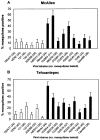Efficiency of dengue serotype 2 virus strains to infect and disseminate in Aedes aegypti
- PMID: 12812340
- PMCID: PMC3050023
- DOI: 10.4269/ajtmh.2003.68.539
Efficiency of dengue serotype 2 virus strains to infect and disseminate in Aedes aegypti
Abstract
Dengue serotype 2 (DEN-2) viruses with the potential to cause dengue hemorrhagic fever have been shown to belong to the Southeast (SE) Asian genotype. These viruses appear to be rapidly displacing the American genotype of DEN-2 in the Western Hemisphere. To determine whether distinct genotypes of DEN-2 virus are better adapted to mosquito transmission, we classified 15 viral strains of DEN-2 phylogenetically and compared their ability to infect and disseminate in different populations of Aedes aegypti mosquitoes. Envelope gene nucleotide sequence analysis confirmed that six strains belonged to the American genotype and nine strains were of the SE Asian genotype. The overall rate of disseminated infection in mosquitoes from Texas was 27% for the SE Asian genotype versus 9% for the American genotype. This pattern of infection was similar in another population of mosquitoes sampled from southern Mexico (30% versus 13%). Together, these findings suggest that Ae. aegypti tends to be more susceptible to infection by DEN-2 viruses of the SE Asian genotype than to those of the American genotype, and this may have epidemiologic implications.
Figures


Similar articles
-
Differential susceptibility of Aedes aegypti to infection by the American and Southeast Asian genotypes of dengue type 2 virus.Vector Borne Zoonotic Dis. 2001 Summer;1(2):159-68. doi: 10.1089/153036601316977769. Vector Borne Zoonotic Dis. 2001. PMID: 12680353 Free PMC article.
-
Aedes aegypti vectorial capacity is determined by the infecting genotype of dengue virus.Am J Trop Med Hyg. 2006 Nov;75(5):886-92. Am J Trop Med Hyg. 2006. PMID: 17123982 Free PMC article.
-
Specific genetic markers for detecting subtypes of dengue virus serotype-2 in isolates from the states of Oaxaca and Veracruz, Mexico.BMC Microbiol. 2008 Jul 15;8:117. doi: 10.1186/1471-2180-8-117. BMC Microbiol. 2008. PMID: 18625078 Free PMC article.
-
Molecular studies with Aedes (Stegomyia) aegypti (Linnaeus, 1762), mosquito transmitting the dengue virus.Parasitol Res. 2017 Aug;116(8):2057-2063. doi: 10.1007/s00436-017-5484-0. Epub 2017 May 30. Parasitol Res. 2017. PMID: 28560571 Review.
-
Evolution of dengue in Sri Lanka-changes in the virus, vector, and climate.Int J Infect Dis. 2014 Feb;19:6-12. doi: 10.1016/j.ijid.2013.10.012. Epub 2013 Dec 11. Int J Infect Dis. 2014. PMID: 24334026 Review.
Cited by
-
Stability and loss of a virus resistance phenotype over time in transgenic mosquitoes harbouring an antiviral effector gene.Insect Mol Biol. 2009 Oct;18(5):661-72. doi: 10.1111/j.1365-2583.2009.00908.x. Insect Mol Biol. 2009. PMID: 19754743 Free PMC article.
-
Dengue--quo tu et quo vadis?Viruses. 2011 Sep;3(9):1562-608. doi: 10.3390/v3091562. Epub 2011 Sep 1. Viruses. 2011. PMID: 21994796 Free PMC article. Review.
-
Differential Effects of Temperature and Mosquito Genetics Determine Transmissibility of Arboviruses by Aedes aegypti in Argentina.Am J Trop Med Hyg. 2018 Aug;99(2):417-424. doi: 10.4269/ajtmh.18-0097. Epub 2018 May 31. Am J Trop Med Hyg. 2018. PMID: 29869610 Free PMC article.
-
Investigating the Clinico-Demographic Characteristics of Dengue Fever and Its Seroprevalence at a Tertiary Care Hospital in Northern India.Cureus. 2024 Apr 5;16(4):e57640. doi: 10.7759/cureus.57640. eCollection 2024 Apr. Cureus. 2024. PMID: 38707003 Free PMC article.
-
DENV-2 Circulation and Host Preference Among Highly Anthropophilic, Outdoor-Biting Aedes aegypti in Dar es Salaam, Tanzania.Viruses. 2025 Jun 5;17(6):818. doi: 10.3390/v17060818. Viruses. 2025. PMID: 40573409 Free PMC article.
References
-
- Sangkawibha N, Rojanasuphot S, Ahandrik S, Viriyapongse S, Jatanasen S, Salitul V, Phanthumachinda B, Halstead SB. Risk factors in dengue shock syndrome: a prospective epidemiologic study in Rayong, Thailand. I. The 1980 outbreak. Am J Epidemiol. 1984;120:653–669. - PubMed
-
- Thein S, Aung MM, Shwe TN, Aye M, Zaw A, Aye K, Aye KM, Aaskov J. Risk factors in dengue shock syndrome. Am J Trop Med Hyg. 1997;56:566–572. - PubMed
-
- Vaughn DW, Green S, Kalayanarooj S, Innis BL, Nimmannitya S, Suntayakorn S, Endy TP, Raengsakulrach B, Rothman AL, Ennis FA, Nisalak A. Dengue viremia titer, antibody response pattern, and virus serotype correlate with disease severity. J Infect Dis. 2000;181:2–9. - PubMed
-
- Cordellier R, Bouchite B, Roche JC, Monteny N, Diaco B, Akoliba P. Circulation silvatique du virus dengue 2 en 1980, dans les savannes sub-soudaniennes du Cote d’Ivoire. Cah ORSTOM Ser Entomol Med Parasitol. 1983;21:165–179.
-
- Roche JC, Cordellier R, Hervy JP, Digoutte JP, Monteny N. Isolement de 96 souches de virus dengue 2 a partir de moustiques captures en Cote d’Ivoire et Haute-Volta. Ann Virol. 1983;134:233–244.
Publication types
MeSH terms
Substances
Grants and funding
LinkOut - more resources
Full Text Sources
Other Literature Sources
Medical
Molecular Biology Databases

